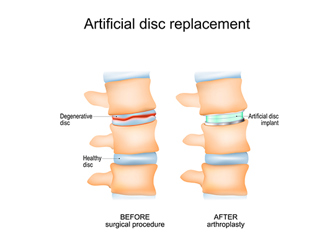
News
What You Need To Know About Cervical Disc Replacements
Date posted: 1/10/2023
Last updated: 1/10/2023
Table of Contents
By Arash Sayari, M.D.
Neck pain is a complex issue for both patients and physicians. While it is a common complaint by most of the patients who see me in the office, the various nuances need to be sorted out so that treatment can be specifically tailored to each individual. Not everyone is a good candidate for a cervical disc replacement (CDR).
Before we talk about CDRs, let’s briefly overview neck pain and its symptoms. Of course, neck pain can involve discomfort with bending or turning your head, and there can also be components of muscle stiffness. However, radiating symptoms (feeling of nerve pain or pain migrating about the neck or arms) can be more concerning and require further evaluation. I will discuss the details “neck pain” further in a separate article, and want to focus on cervical disc replacements here.
Nerve pain can be with or without neck pain, and is what we call “radiculopathy,” or pinching of a nerve. These nerves come from the spinal cord and feed the muscles in our trapezius, latissimus, shoulders, arms, hands, and fingers, and nerve pain can shoot from the neck down the arm in various distributions.
Here are a few causes of neck pain and cervical radiculopathy:
- Herniated disc: A herniated disc occurs when the soft center of a spinal disc bulges out and puts pressure on a nearby nerve. This can lead to neck pain, as well as pain, numbness, and tingling in the shoulders, arms, and hands.
- Degenerative disc disease: This occurs when the discs between the vertebrae in the neck wear down over time, leading to nerve compression. This can cause neck pain, as well as pain, numbness, and tingling in the shoulders, arms, and hands.
- Bone spurs: These small, bony growths can form on the vertebrae and put pressure on nearby nerves. This can cause neck pain, as well as pain, numbness, and tingling in the shoulders, arms, and hands.
- Spinal stenosis: This condition occurs when the spinal canal becomes narrowed, leading to nerve compression. This can cause neck pain, as well as pain, numbness, and tingling in the shoulders, arms, and hands.
While pinching of a nerve is different from pinching of the spinal cord, both forms of stenosis can be treated with cervical disc replacement. Spinal cord compression will also be discussed in another article.
Like most spinal conditions, we always want to try non-surgical treatment methods first. This includes medications, activity modification, physical therapy, and injections. When these fail, you may be a good candidate for a CDR.
Cervical disc replacement (CDR) is a surgical procedure that involves replacing a damaged or degenerative disc in the neck with an artificial disc.
It is a less invasive alternative to spinal fusion surgery.
Cervical disc replacement is a less invasive alternative to spinal fusion surgery, which involves fusing two or more vertebrae together. While spinal fusion can be effective for relieving neck pain and improving stability, it can also result in a loss of motion in the neck. CDR, on the other hand, allows for the preservation of normal neck movement.
It can be performed using minimally-invasive techniques.
CDR can be performed using either traditional open surgery or minimally-invasive techniques. Traditional open surgery involves a larger incision and a longer recovery period, while minimally-invasive techniques involve smaller incisions and a shorter recovery period. I personally use minimally-invasive techniques.
The artificial discs used in cervical disc replacement are designed to mimic the natural movement and function of the cervical spine.
Artificial discs used in CDRs are typically made of materials such as metal or plastic and have a flexible center that allows for a range of motion similar to that of a natural disc.
The top and bottom plates of the artificial disc are made of metal or plastic and are attached to the vertebrae above and below the damaged disc. The flexible center is typically made of a material such as polyethylene or a cobalt-chrome alloy and is designed to allow for a range of motion similar to that of a natural disc.
There are various FDA-approved CDRs on the market. Each is made with various combinations of materials including titanium, stainless steel, polyethylene, and ceramic. I have access to these various implants and select the one to implant based on my patients’ various needs. This allows me to offer a patient-specific treatment protocol.
Cervical disc replacement can be an effective treatment for neck pain and stiffness.
In clinical studies, individuals who underwent cervical disc replacement reported significant improvements in pain and function compared to those who did not have the surgery, especially neck pain, stiffness, strength, and arm pain.
Artificial discs are designed to withstand the normal wear and tear of the cervical spine and are typically expected to last for many years. However, as with any implant, there is a risk of wear or failure over time, and individuals who have undergone cervical disc replacement may need to have the implant replaced at some point in the future.
There are potential risks and complications associated with cervical disc replacement.
As with any surgical procedure, there are potential risks and complications associated with CDR. These may include infection, nerve injury, and bleeding. This is why I always go over all the risks, benefits, and alternatives of surgery before deciding on an appropriate treatment plan with my patients.
Most individuals can return to their normal daily activities within a few weeks of the surgery, but it may take several months for things to fully heal and for individuals to experience the full benefits of the surgery. It is important to follow our teams’ recommendations for post-operative care and to allow the neck sufficient time to heal to optimize your outcome following surgery.
The recovery process following cervical disc replacement surgery can vary depending on the specific technique used, the individual's overall health, and other factors. In general, however, most individuals can expect to experience some discomfort and stiffness in the neck for the first few days after the surgery. Pain medication may be prescribed to help manage this discomfort.
It is important to follow the specific instructions provided by the surgeon for post-operative care, which may include taking prescribed medications, getting enough rest, and avoiding strenuous activities for a period of time. Physical therapy may also be recommended to help individuals regain strength and mobility in the neck. Physical therapy exercises may focus on stretching and strengthening the neck muscles, improving the range of motion, and improving posture. The therapist may also teach individuals how to perform daily activities in a way that minimizes strain on the neck.
Overall, cervical disc replacement is an effective treatment option for specific individuals with pressure on the spinal cord or nerve roots.
About Dr. Sayari
Dr. Arash Sayari is a fellowship-trained orthopedic spine surgeon focusing on the neck, spine, and low back. Dr. Sayari offers free MRI reviews and telehealth options. If you are interested in a consultation regarding your neck to discuss your diagnosis and treatment in further detail, schedule an appointment here.

